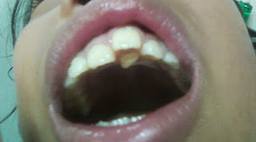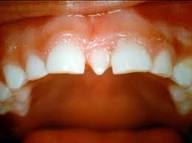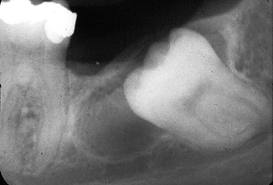We have discussed hypodontia in the part I of this article. Here we will look at extra teeth in addition to those in the normal dentition.

Extra tooth
Hyperdontia
Hyperdontia, or supernumerary teeth, are teeth additional to those in the normal series. They can be found anywhere in the tooth-bearing region. They are most commonly found in the upper front tooth region, followed by the lower back tooth region. Just like hypodontia, they can be present on both sides (right and left sides) of the dentition. Hence, when there is a supernumerary tooth on one side of the jaw, a dentist would check for the possibility of a supernumerary tooth on the other side as well.
Types of supernumerary teeth
1. Mesiodens
A mesiodens is the most common supernumerary tooth. It is an extra tooth that develops between the two front upper permanent incisors. The shape is usually conical and smaller in size (about half the size of the adjacent incisors), and they have short roots.
2. Paramolar
A paramolar is an extra molar that grows next to molar teeth, and are usually erupted to the side of the tooth (out of the arch of normal dentition).
3. Distomolar
A distomolar is an extra molar found behind the 3rd molar.
4. Supplemental tooth
Extra teeth that looks like one of the normal teeth in the human dentition are called supplemental teeth. They are mostly smaller in size compared to their counterparts.
Causes
There is no exact or evidential cause for hyperdontia, however it is believed that supernumerary teeth can be inherited, or due to environmental or genetic causes. It is associated with some syndromes such as:
i) Cleft lip and/ or palate
In patients with cleft lip and/ or palate, it is often normal to find supernumerary teeth in the region of the cleft. These supernumerary teeth are often small, conical in shape, and is situated on each side of the cleft area.
ii) Cleidocranial dysplasia
This name is derived from the words “cleido” (which means clavicle), “cranial” (head), and “dysplasia” (abnormal formation). The symptoms of patients with this condition includes partial or total absence of clavicle bone, such that the patient can even touch their shoulders in front of them, hypertelorism (increased distance between the 2 eyes), hearing loss and frequent infections, high roof of the mouth and possible cleft, and supernumerary teeth.
iii) Gardner syndrome
These patients have multiple large bowel polyps in childhood and adolescence, multiple benign bone tumours in the jaw, and skin cysts and fibromas.
iv) Oral-facial-digital syndrome
Problems caused by supernumerary teeth
1. Crowding
Even with a normal 32 teeth in a jaw, sometimes there is not enough space for them to grow nicely, leading to crowding. With extra teeth, the individual is even more prone to crowding.
2. Impaction
The presence of an extra tooth can also prevent the eruption or cause malposition of the adjacent normal tooth.
3. Resorption of adjacent teeth
If the extra tooth is unerupted and its growith is towards another adjacent tooth, when its crown tries to erupt out of the mouth, it can actually cause physiological resorption of an adhacent tooth.
4. Dentigerous or follicular cyst
Unerupted teeth stands a risk of developing dentigerous cysts around its unerupted crown of the tooth. These cysts will then have to be removed.
5. Poor appearance
Crowded teeth and mesiodens can be an unpleasant sight and a cause for lack of self-confidence.
6. Affect occlusion
A supernumerary that has erupted out of the arch of teeth on the jaw can cause premature contact with the opposing jaw, leading to altered occlusion which may be uncomfortable and cause more problems, especially to your jaw joints (the temporomandibular joint, or TMJ) in the future. An extra teeth can also cause a normal tooth to be pushed out of the arch and cause a similar problem.
Management:
1. No treatment if it doesn’t cause any of the problems mentioned above, and the patient is willing to accept the appearance. The patient should go for regular dental reviews to observe any changes or disturbances caused by extra teeth.
2. Extraction
Extra teeth causing crowding, impaction, cyst formation, or resorption of the adjacent tooth, should be extracted
3. Occlusal adjustments
This applies in cases where extra teeth has affected the normal occlusion.
4. Orthodontic treatment
After extraction of supernumerary teeth, eg. a mesiodens, orthodontic treatment may be required to close up the space created and to align the rest of the teeth into a neat row of teeth.


